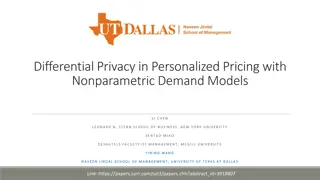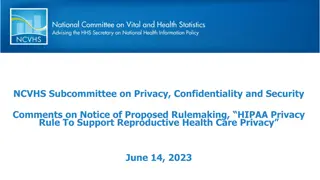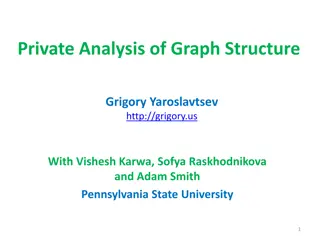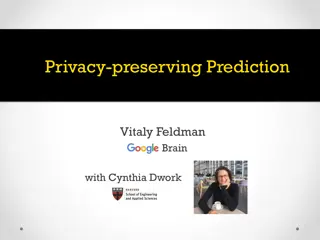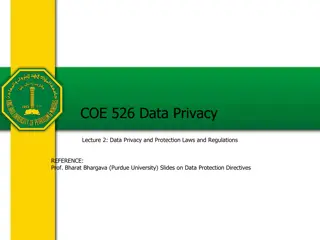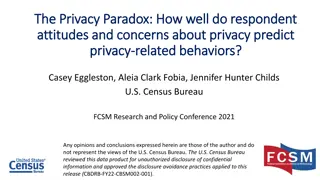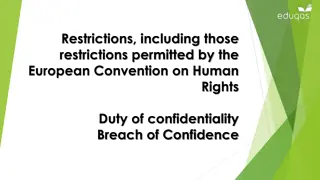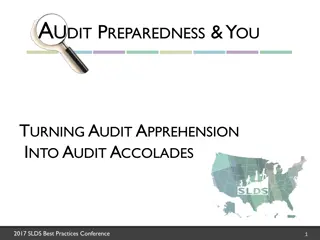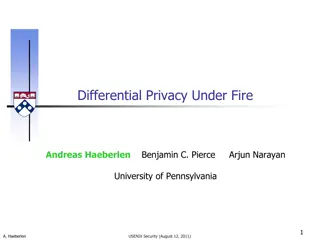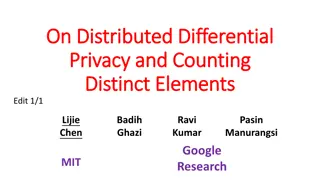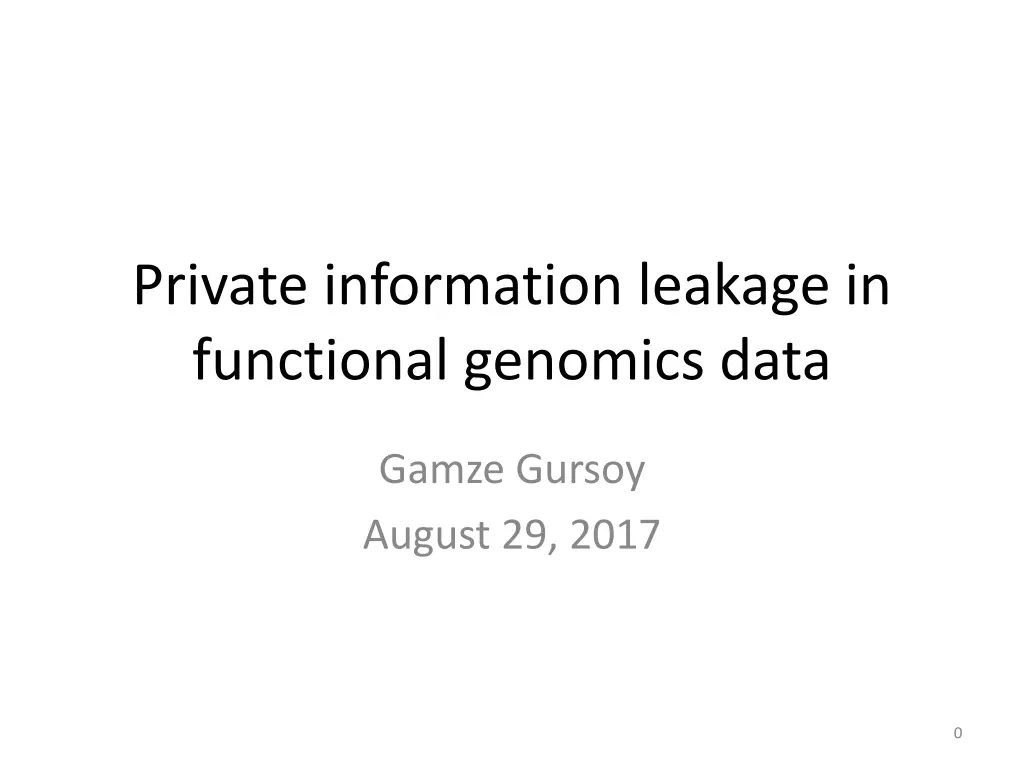
Information Leakage in Functional Genomics Data Analysis
Explore methods to quantify and assess information leakage in functional genomics data, including Hi-C, ChIP-Seq, and RNA-Seq. Examine the implications of leaked information on individual identification within a population.
Download Presentation

Please find below an Image/Link to download the presentation.
The content on the website is provided AS IS for your information and personal use only. It may not be sold, licensed, or shared on other websites without obtaining consent from the author. If you encounter any issues during the download, it is possible that the publisher has removed the file from their server.
You are allowed to download the files provided on this website for personal or commercial use, subject to the condition that they are used lawfully. All files are the property of their respective owners.
The content on the website is provided AS IS for your information and personal use only. It may not be sold, licensed, or shared on other websites without obtaining consent from the author.
E N D
Presentation Transcript
Private information leakage in functional genomics data Gamze Gursoy August 29, 2017 0
Objectives 1- How can we quantify the information leakage in functional genomics data (Hi-C, ChIP-Seq, RNA-Seq)? 2- Is the leaked information enough to identify an individual in a population of individuals? 1
Quantification of Information Leakage Privacy preserving mapping S set of variables that should remain private Y set of measurements that S can be inferred U distorted version of Y S Y U Privacy preserving mapping PU|Y(.) Calmon and Fawaz,2012 Example: S: Set of SNPs Y: WGS data U: Summary statistics Assume: S: Set of SNPs Y: WGS data private data U: reads from FGE public data Can we asses the leakage in U? 2
* Let S be a set of SNVs that can directly be inferred from Y S={S1,S2,..,Si, ,SN} Total information that Y contains can be defined as: where ni=total number of individuals with SNV Si in a database d Let S is a subset of S, which are the SNVs that can be directly inferred from U; S is a subset of S, which are the SNVs that can be imputated from U with confidence (0,1] S ={S 1,S 2,..,S i, ,S N } S ={S 1,S 2,..,S i, ,S N } P={ 1, 2,.., i, , N } Relative information that U contains with respect to Y 3
Data Experiment Total reads Sequencing length Total coverage(bp) WGS 757,704,193 250 189,426,048,250 Hi-C exp 1 PE1 219,616,072 101 22,181,223,272 Hi-C exp 1 PE2 220,087,882 101 22,228,876,082 Hi-C exp 2 PE1 448,843,710 101 45,333,214,710 Hi-C exp 2 PE2 451,088,484 101 45,559,936,884 Hi-C exp 3 PE1 536,684,803 101 54,205,165,103 Hi-C exp 3 PE2 536,101,709 101 54,146,272,609 RNA-Seq 227,501,266 202 45,955,255,732 4
The slope of the curve can show the difference When we assume an exponential fit Information ~ coverage^m log(I)~m*log(c)+n 7
Hi-C provides more information than WGS in short coverages R^2~0.99 for all 8
Hi-C provides more information than WGS in short coverages 9
Hi-C provides more information than WGS in short coverages Difference between the gold standard (1k genome SNVs) and the SNVs from the experiments at every coverage also shows how close the genotypes from experiments to the real genotypes 10
First gap fold change Measure to show how well we can identify the individual from a panel of individuals d_1 d_2 11
Hi-C identifies individuals better than WGS at low coverages, equally at high coverages 12
How does RNA-seq fit into this picture? Answer: poorly! 14
Tough still can identify NA12878 even at low coverages! First gap fold change 15
Which one of the assays does better SNV calling in the transcriptome? 16
More Data: ChIP-Seq Experiment H3K4me1 HDGF RELB CTCF-Snyder H3K4me3 JUND rnap2 H3K79me2 H3K36me3 H2AFZ H3K9me3 CTCF-Broad rnap2 H3K27ac H3K4me2 H4K20me1 H3K27me3 H3K9ac CTCF-Iyer rnap2 PBX3 Total reads Sequencing length Total coverage (bp) 42,763,056 41,626,373 25,652,682 25,463,397 20,221,959 18,701,295 17,677,527 16,073,184 15,239,685 14,724,790 14,049,420 11,026,086 10,428,778 10,410,928 9,815,194 9,757,368 8,454,639 7,981,456 7,614,943 7,516,461 6,119,046 36 1,539,470,016 4,204,263,673 2,590,920,882 916,682,292 727,990,524 673,246,620 636,390,972 578,634,624 777,223,935 530,092,440 505,779,120 562,330,386 375,436,008 530,957,328 500,574,894 497,625,768 431,186,589 407,054,256 266,523,005 270,592,596 220,285,656 101 101 36 36 36 36 36 51 36 36 51 36 51 51 51 51 51 35 36 36 17
NA12878 is vulnerable even at the lowest coverage 19
Putting together all the functional genomics data at their highest coverage 20
Depth analysis on Chr1 for Hi-C exp1 PE1 and WGS Depth of SNVs missed by Hi-C Depth of FPs mean=16 mean=4 * Hi-C missed SNVs have relatively low depth than the captured SNVs * misrepresentation * Hi-C FPs have relatively high depth than the captured SNVs * overrepresentation * also contains misrepresented bps detected as false positive indels mean=9 21
EN-TEx Data Hi-C does better 10X SNV calling compared to WGS ENC-002 (1K2DA) transverse colon data Gold Standard = WGS Gold Standard = 10X Total # of gold standard SNVs SNVs called from Hi-C Matching Hi-C SNVs False Positives Accuracy FPR 4,467,330 4,154,507 3,666,194 985,924 82% 24% Total # of gold standard SNVs SNVs called from Hi-C Matching Hi-C SNVs False Positives Accuracy FPR 4,334,605 4,154,507 3,650,755 503,752 84% 12% 22
Muscle+Colon Hi-C does better capturing Colon SNVs then Colon Hi-C 10X SNVs for colon! Colon Muscle Total # of gold standard SNVs SNVs called from Hi-C Matching Hi-C SNVs False Positives Accuracy FPR 4,334,605 3,902,259 3,224,822 677,434 74% 17% Total # of gold standard SNVs SNVs called from Hi-C Matching Hi-C SNVs False Positives Accuracy FPR 4,334,605 4,154,507 3,650,755 503,752 84% 12% Colon+Muscle Total # of gold standard SNVs for colon! SNVs called from Hi-C Matching Hi-C SNVs False Positives Accuracy FPR 4,334,605 4,651,818 3,699,619 952,199 85% 20% 23
Next week: Imputation Note to self: Dan Geschwind has brain cell specific hi-c data, 4 individuals 3? cell types. It was published a year ago: not sure if those individuals have WGS? This sample record is submitted but not yet released for the dbGaP study phs001190. Should I email to ask for the data? 24


